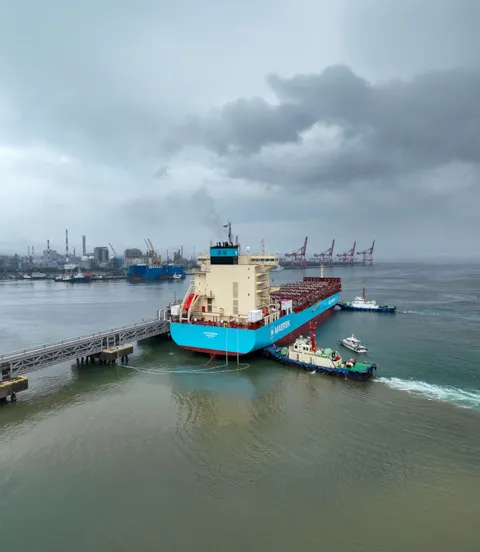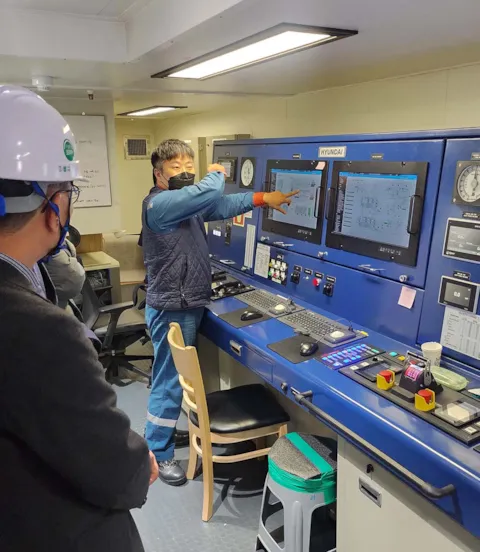DNV Korea’s Decarbonization Network drives low-GHG fuel initiatives
At the end of 2023, Ulsan Port Authority, a major energy distribution hub and a pioneer of the energy transition in the region, joined DNV Korea’s Decarbonization Network. The benefits are mutual, with the network partners committed to sharing knowledge and aligning their efforts to facilitate low-GHG fuel uptake.
There have been many initiatives in the Korean maritime sector in recent years to not only keep abreast of decarbonization but actually become one of its driving forces. To encourage these efforts and create synergies by helping the stakeholders coordinate their activities, DNV Korea invited companies from all parts of the Korean maritime sector to join its Decarbonization Network.
Helping the industry navigate decarbonization challenges
Established in 2022, this project provides a collaboration platform for shipyards, shipowners, charterers, ports, research facilities and financial institutions involved in decarbonization activities. In regular meetings, seminars and workshops, the members – currently 27 companies from all segments of the maritime industry – explore current trends, share insights and best practices, discuss regulatory and technical challenges, and promote the development of solutions.
“We want to use the Decarbonization Network to identify decarbonization leaders in the Korean maritime sector and provide them with crucial information to help them navigate the challenges they’re facing,” explains Jae Hun Lim, Principal Engineer and Decarbonization Expert at DNV Korea who has spearheaded the initiative. DNV puts an emphasis on educating and developing future decarbonization experts at these companies, all with the perspective of extending the network beyond national borders eventually. The practical value of the network is already evident. Members have applied insights directly to projects, such as the Vessel Technical Index (VTI), a ship performance indicator developed by DNV. After learning about VTI through network meetings, members were better prepared to respond to inquiries from charterers they received shortly after. This kind of readiness is supported by DNV’s global expert network and regional hubs, which enable faster knowledge-sharing and closer alignment with international decarbonization efforts.
A key member of the decarbonization network: Ulsan Port Authority
The Ulsan Port Authority (UPA) joined the network in December 2023. Sometimes called the “industrial powerhouse of South Korea”, Ulsan is the nation’s largest industrial port. Its expansive tank terminal cluster serves as a bunkering supply base for other ports in south-eastern Korea. Ulsan is also a major shipbuilding centre, and home to the headquarters of HD Hyundai Heavy Industries Co., Ltd. With huge industrial complexes right at the port and in its immediate hinterland, Ulsan is in an ideal position to put its weight behind industry efforts to build a global green ship fuel supply chain. The port is working on expanding and partially converting its liquid cargo hub for low-GHG fuels.
As a key player in Korea’s decarbonization efforts, UPA is a welcome addition to the network, says Jae Hun Lim. “UPA was the world’s first port to implement a green methanol bunkering system and began supplying green methanol to ships recently,” he says. “Ulsan has pioneered the use of hydrogen as fuel and is in the process of establishing a facility for bunkering bio ammonia.”

Establishing a Green Corridor across the Pacific Ocean
In April 2025, South Korea and the United States agreed to establish a green shipping corridor between the two nations as of 2027. Supported by various public and private entities including the Busan and Ulsan port authorities, the project roadmap includes the development of infrastructure and a supply base for alternative marine fuels, mainly ammonia and green methanol.
“Ulsan’s role is to make sure the right infrastructure is in place,” says Soon-Yo Jeong, Vice President of Operations at the Ulsan Port Authority. “We’re focusing on bunkering systems for methanol and ammonia, and on developing safe and clear standard operating procedures.”
In 2023, Ulsan Port was selected as a strategic hub for eco-friendly marine fuels under the South Korean government’s Alternative Marine Fuel Supply Chain Development Plan, adds Jeong: “We see this as both a responsibility and an opportunity.”

UPA’s 2030 vision: Sustainable energy hub with offshore wind complex
UPA wants to have its sustainable energy logistics hub in place by around 2030, including comprehensive infrastructure for the import, storage, processing and delivery of carbon-neutral energy. Many construction projects are in progress or in the planning stages to support the energy transition in general, and the Green Corridor in particular.
Right next to the site of the planned sustainable energy hub, an offshore wind support pier is under construction, scheduled for completion in 2028. Several power generation companies are developing an offshore wind energy complex that will include floating wind turbines with a generation capacity of 6.2 GW. At least some of this power will be converted to renewable fuels locally. “Our goal is to grow from a traditional oil logistics hub into a clean-energy port that can support the needs of future shipping,” says Soon-Yo Jeong.

Addressing decarbonization challenges in port operations
Such an enormous undertaking is not without technical and strategic challenges, Jeong concedes. First and foremost, shore power infrastructure is still very limited, with only about 3 per cent of global ports currently offering shore-side electricity, he adds. “Building this infrastructure requires major grid upgrades and coordination between terminals, utilities and vessel schedules,” he says.
In the larger context of the Green Corridor and the IMO decarbonization ambition, the challenges only grow: “Ammonia presents safety and regulatory challenges. It’s toxic and corrosive, and international guidelines for safe bunkering are still under development. Ports must plan carefully to ensure future infrastructure meets the highest safety standards.”
What is more, demand for alternative fuels like ammonia is still emerging. “As of now, only around 39 ammonia-fuelled vessels are on order globally, whilst the fuel remains 2 to 4 times more expensive than conventional marine fuels,” Jeong points out. “Building infrastructure ahead of demand is a calculated risk, which makes cross-sector coordination even more important.”

Coordinated efforts essential for a sustainable energy transition
Enacting this coordination between all the players – such as ports, shipowners, regulators and fuel producers – is a complex task, says the Operations VP: “To succeed, we must work together and agree on common goals. The DNV Decarbonization Network connects Ulsan Port to a global network of industry peers, regulators and fuel suppliers, encouraging structured dialogue and alignment across stakeholders. Through this network, we gain early access to information about new regulations, market trends and emerging technologies. This helps us make well-informed decisions and benchmark our progress against other leading ports.”
The network also enhances trust, Jeong continues: “By working alongside other ports and companies, we’re not developing in isolation – we’re contributing to a shared global vision for clean-energy shipping. This is why international networks like this one are so valuable. They help ports learn from each other, share risk and align efforts.”

Network provides decision support and improved visibility
The Decarbonization Network’s monthly meetings make it easier for everyone to stay up to date on new developments. “We share updates, exchange good practices and join pilot projects,” says Jeong. “DNV’s insights into international safety guidelines, fuel trends and infrastructure planning help us stay aligned with global standards and understand what’s coming next so we can make better decisions and reduce risks.”
By connecting the stakeholders and organizing knowledge and collaboration, the DNV Decarbonization Network supports its members’ efforts to apply decarbonization solutions and to provide the infrastructure needed for methanol, ammonia and other alternative fuels in a safe and practical way whilst helping them secure their competitiveness and take the lead in the global market for sustainable marine fuel bunkering. Plus – as an information sharing and coordination platform, the network is open and ready to welcome new members at any time, emphasizes DNV’s Jae Hun Lim.
- Ulsan Port Authority
